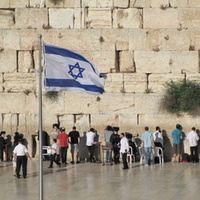There are some people in the course of their 12 step work who find connecting to G-d via kneeling to be an important part of their recovery. There is a degree of cultural inhibition regarding kneeling for Jewish people, as this is not our customary form of worship. Below is an analysis of the pertinent halachic issues.
The verse states in Vayikra 26:1 "…and a Maskis stone shall not be placed in your land to bow upon it." The definition of maskis according to Rashi is a stone that covers the ground (such as stone flooring), according to Onkelos is a kneeling stone, and according to Ibn Ezra a decorative stone used for worship.
There are three terms used by Chazal when referring to various forms of bowing during prayer. Keriya, Kida and Hishtachavaya. Keriya is kneeling on one's knees. Kida is bowing down on the floor, and Hishtachavaya is laying down with face on the ground and hands and feet spread out. (See Rambam Hilchos Tefila 5, as codified by Aruch Hashulchan 131:4.)
Regardless of the interpretation of the words, the Rema in Shulchan Aruch (O.C. 131:8) codifies the Torah prohibition to lie flat on stone with hands and feet spread out in worship (Hishtachavaya), even if it is in worship to Hashem.
The Torah prohibition is only in regard to actual stone and fully spread out bowing with face on the floor and hands and feet spread out (see Mishna Berura Op. cit. 40.) Also, man-made bricks are not considered stone in regard to the Torah prohibition (see Mishna Berura Op. cit. 41, from this point and on referred to as "M.B.".)
However, there are additional rabbinic prohibitions to prevent people from erring and violating the Torah prohibition. Thus, Chazal prohibit either fully spread out bowing with face on the floor and hands and feet spread out (Hishtachavaya) on even on a regular non-stone surface, or bowing down on the floor (Kida) even on stone. (M.B. 40.)
Notwithstanding these prohibitions, Chazal permit forms of bowing that are two steps removed from the original Torah prohibition. Thus, bowing down ( Kida) on a non-stone floor, or even bowing down (Kida) on a stone floor with some sort of alteration, such as leaning to the side or placing an additional cloth barrier on the floor. In addition, it even would be permissible to perform fully spread out bowing with face on the floor and hands and feet spread out (Hishtachavaya) on a non-stone surface if there was also a some sort of alteration, such as leaning to the side, as this is still two steps removed from the Torah prohibition (cloth barrier may not work here). See M.B. 40 and 41.
There is also an additional prohibition to perform even the permitted forms of Hishtachavaya and probably Kida in public, as it may be construed as arrogant and if the prayer of such apparent intensity is not answered it may create a disgrace. This prohibition is strictly when one person performs this act in public, however if a group of people do it together in public, or an individual does it privately there is no problem. (M.B. 38.)
In the final analysis, although there are some prohibitions regarding forms of bowing, kneeling (Keriya) in one's home on a carpet would seem to be far away from any prohibition. First, because kneeling alone is not even defined as Kida or Hishtachavaya, and thus was never prohibited. And, second, because the floor is not stone and is covered.
Rabbi Simcha Feuerman
718 793 1376

 Previous
Previous

